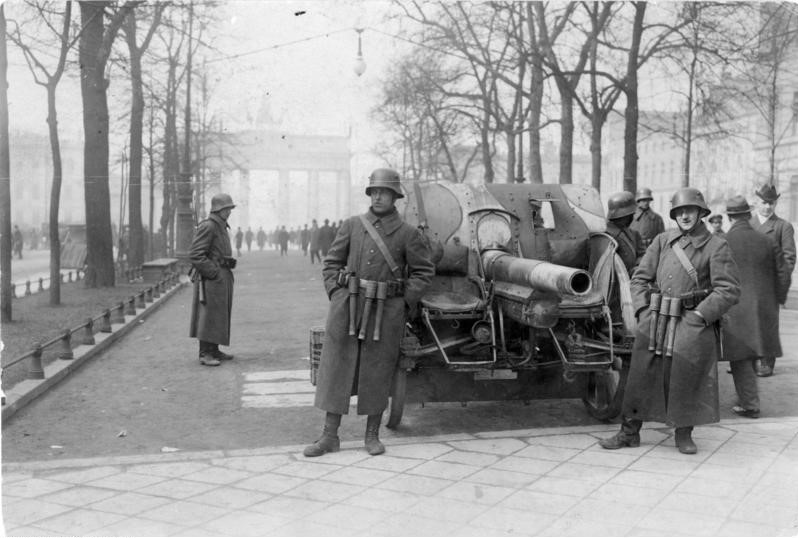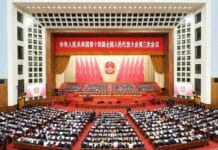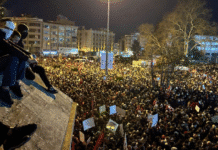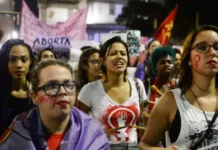How the German working class fended off a right-wing coup, almost seized power and was once again betrayed by the Social Democratic Party
Marcus Hesse SAV (ISA in Germany)
One often hears that a general strike is not possible in Germany, let alone a revolution. But a hundred years ago the German working class came very close to seizing power. In Saxony, Thuringia and especially in the Ruhr area, a Red Army was formed. A general strike defeated a right-wing military coup against the republic, which ended in an embarrassing disaster after just five days.
For a short time, it looked as if the working people could realise their vision of a socialist transformation. The workers grasped power. But the Social Democratic Party (SPD) government and the trade union bureaucracy were afraid of this. The SPD now used the same military, which just a few days before it had overthrown the government, against the workers’ uprising. This betrayal took place just over a year after the murder of Liebknecht, Luxemburg and many other revolutionaries.
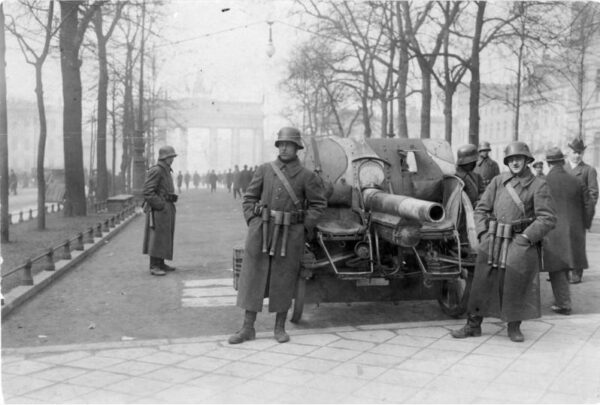
Photo: Bundesarchiv Bild 183-H25109, Unknown author
November Revolution. Round one.
When in November 1918, a mutiny by the Kiel sailors started a national uprising, which brought down the monarchy and the empire, workers’ and soldiers’ councils formed overnight in almost every large city. For a few weeks, power lay in their hands. At the end of the war, even the middle classes were ready for socialism. But unlike in Russia, a revolutionary party was missing. Most of the soldiers returning from the front trusted their old leaders from the SPD, a party they had built up at great sacrifice. The more left wing Independent Social Democratic Party (USPD), and even more so the Spartacus League, which became the German Communist Party in 1919 organised only a small politically-conscious minority of the working class.
The SPD leaders used their authority to divert the revolution back to defend the bourgeois order and the parliamentary system. They managed to persuade the workers’ and soldiers’ councils to practically dis-empower themselves. At the same time, they made pacts with the generals of the old army to take violent action against the revolutionary activities of the workers.
The revolutionary workers resisted. The SPD leaders, the President Friedrich Ebert and Defence Minister Gustav Noske then used the military against them. The regular military was joined by right-wing extremist combat units called the Freikorps. They were to restore “order” against the “Spartacist threat”. There were even recruitment adverts for the Freikorps carried in the SPD party organ “Vorwärts” (Forward).
Ebert commented at the time that: “I hate the revolution like sin!” His minister Noske said: “One must become the bloodhound. I don’t shun the responsibility!” He followed words with bloody deeds. In January 1919, the so-called Spartacus Uprising in Berlin was crushed, the revolutionary People’s Navy Division was disarmed and the leftist police chief and member of the USPD Emil Eichhorn was deposed. Rosa Luxemburg, Karl Liebknecht and Leo Jogiches were murdered.
The bloody defeat of the revolutionary struggles had an effect: the parliamentary elections of February 1919 brought the SPD and the bourgeoisie a majority. The USPD remained weak and the KPD boycotted the elections against Rosa Luxemburg’s advice. But already in March the workers reacted with political strikes against the brutal repression carried out by the army and the Freikorps, who Noske had deployed to every city where there had been a proletarian uprising. In those cities martial law ruled. Some of these Freikorps and the military had previously trained in colonial wars in Africa, like General Maercker. The terror that he had previously perpetrated against the “natives” was now taken by his troops into the German workers’ quarters.
In Bremen, a soviet republic was militarily suppressed — in Hamburg there were revolts against food controls. The Freikorps were particularly brutal in Munich, where in April 1919 a socialist soviet republic had been proclaimed and which lasted for a few weeks. This was crushed by Freikorps of the infamous Naval Brigade Ehrhardt, which went on to play a major role in 1920 — with the approval of the SPD leadership.
The massacre by the Freikorps was so severe, they even accidentally shot participants in a meeting of a Catholic fellowship because they were workers and looked like Spartacists. Heroic leaders of the soviet republic like Eugen Leviné and others were executed. After that, Munich become a breeding ground for fascist groups. Not without reason, the Nazi Party (NSDAP) was founded there in 1919.
A republic hardly anyone wanted.
During the year 1919, the workers’ and soldiers’ councils were gradually replaced by the bourgeois state. At company level, they continued to have some influence for a long time to come. But the government and the trade union bureaucracy increasingly dis-empowered them and gradually transformed them into the works councils that still exist today and are committed to peace with the bosses. A pact between the union leadership and the country’s largest capitalist, Hugo Stinnes, sealed this.
The SPD’s betrayal could not be hidden from the workers. The USPD and KPD both grew and, temporarily, were equally strong while the bloodhound Noske became a hated figure. The still young KPD, however, had been robbed of its outstanding minds including Luxemburg and Liebknecht, was at times operating illegally, and entangled in internal faction fights, for example about whether it should participate in parliamentary elections as a revolutionary party or work within the big unions. The ultra-left wing, which rejected just this approach, was initially strong and split off to form the APD.
But the workers continued to reject capitalism. Even after the March strikes of 1919 and the suppression of the soviet republics, labour struggles continued. In January 1920, there was a large demonstration of 100,000 people in front of the Reichstag in Berlin against the new Works Councils Act, which was intended to restrict the rights of works councils. The government unleashed the military and paramilitary security police on them, who fired into the crowd. More than forty people were killed and a hundred injured. The general responsible for the massacre was Herr von Lüttwitz, who was to stage a coup against the Republic just two months later. It was after this that the ban on protests within a mile of the German parliament was introduced and is still in force today.
But the parliamentary republic with its formal democracy, its social concessions to the workers and the right to vote for women was already too much for the radical right. The Freikorps, which had been let loose against the revolutionary workers by the Ebert/Noske government were armed to the teeth. There was also a paramilitary security police and armed civilian militias. A large part of the later SA and SS formations and Nazi leaders came from these groups. They represented anti-semitic ideas. The swastika symbol was already displayed on the helmets of the Ehrhardt Naval Brigade in 1919.
The bourgeois republic was supported by the SPD, the Catholic Centre and the liberals. They were also the ones who conducted negotiations with the Allies on reparations for the war and signed the Treaty of Versailles, which placed the sole blame for the war on Germany, demanded billions in compensation from the population and was therefore hated by almost everyone in Germany.
The radical right took this as an excuse to step up their agitation. While the republic was already too much for the right and the old elites, it offered too little to the workers. The capitalists and the old state apparatus were still there. Whoever wanted to change this, would feel the combined power of the state and its allies, the right wing.
The right wing stages a coup. Ebert pulls out.
In March 1920, the right saw its time to strike out against the republic and the strong workers’ movement. The excuse was given when Ebert and Noske decided to downsize the Reichswehr under pressure from the British and French bourgeois. The dissolution of the “Freikorps” was also to be enforced. This prompted General Lüttwitz and the right-wing politician Kapp to launch a military coup against the Ebert government. Other right-wing radicals and military men joined them. Among them the Brigade Ehrhardt and people like Waldemar Pabst, the murderer of Rosa Luxemburg.
The Putsch was supported by a Who’s Who of German right-wing radicals and fascists, even before the term gained worldwide notoriety, who formed conspiratorial associations such as “National Unification”. Entrepreneurs like Hugo Stinnes and other capitalists generously donated money. Today we know that the SPD government had previously been warned of the coup. But they did nothing. It is revealing that the putschists had even tried to win over SPD minister Noske. But he was not prepared to go that far.
On the night of 12–13th March, the Ehrhardt Brigade marched on Berlin. The Social Democratic government of Ebert was declared deposed, strikes and demonstrations were banned, and martial law was declared. Ebert and Noske fled, cowardly as they were, to Dresden to try and gain the backing of Reichswehr General Maercker, who had gained notoriety by murdering workers in 1919. Although he did not join the putschists, neither was he prepared to stand against the coup or defend parliamentary democracy. So the SPD leaders had to pack their bags again and fled to quiet Stuttgart. When they saw that no section of the military was prepared to protect them, they had to rethink.
In many places, revolutionary executive councils of leftists and trade unionists from below sprung up against the right-wing coup. They networked, in many places they stopped working and armed themselves. Ebert and Noske, having been left defenceless decided to appeal to the working class to get them out of the situation they had created for themselves. The right-wing SPD man and ADGB trade union leader Legien was supposed to arrange this. Negotiations between the workers’ organisations took place. As a result, the SPD, USPD and unions called for a general strike against the right-wing coup on 14th March, 1920.
The KPD initially refused to participate, not wanting to support Ebert and Noske, but joined in just one day later. Many KPD members had already taken part in the strike on the first day. The general strike was almost all-encompassing, spreading from workers to employees and the civil service. In the Ruhr area alone, 100,000 miners went on strike, several million throughout the country. The putschists failed. There were no trains running, the electricity supply was switched off, and nothing worked anymore. After only five days, the nightmare was over. Kapp fled abroad, Lüttwitz resigned. Ebert & Co. returned to the government. Noske had to resign, so hated he was by the workers.
The trade unions supporting the general strike agreed on 18th March on a joint nine-point program with far-reaching demands, including the socialisation of companies and expropriation of large farmlands and a purely socialist government. Otherwise, they wanted to continue the strike. After negotiations with the governing parties, a compromise was reached on 20th March: the essential demands of the nine-point program were accepted in a watered down form. However, pressure from the USPD led to further negotiations and further concessions. In the end, however, most assurances were withdrawn after a short time. The putschists faced ridiculously mild punishments. The “Freikorps” were gradually integrated into the regular Reichswehr and the state apparatus. Those who were not did not remain unemployed for long: they poured into the new nationalist parties and their combat units.
Central Germany and the Ruhr. From general strike to armed revolt.
Already during the general strike, armed associations of the working class were formed in the industrial centres. They were organised across party lines and consisted of communists, left-wing socialists and trade-unionists. In the Ruhr area, they called themselves the “Red Army”, after the Russian model and that of Munich in 1919.
In the central German industrial area, armed workers proclaimed a soviet republic, supported by militant works councils. They formed a “revolutionary Volkswehr”. In the Vogtland, the unemployed communist Max Hoelz made a name for himself as the “Red Robin Hood”, who with his guerrillas forcibly confiscated the goods of the rich and distributed them to the poor of the region. As a result, the Reichswehr and Freikorps marched again into Saxony and Thuringia. In the Ruhr area, a strong Red Ruhr Army was formed, comprising about 80,000 fighters. Power was once again within reach for the communist workers.
The SPD government of Ebert reacted as it had in November 1918, using the military and armed right-wing radicals, who had just staged a coup against the SPD against the revolutionary workers. The uprising of the Red Army of the Ruhr and the workers who sympathised with it was crushed in April 1920 by the Freikorps and Reichwehr units commanded by Lieutenant General Oskar von Watter. In many places, civil defence units were deployed as well as the heavily armed Security Police. There were several massacres. The reaction of the miners of the Ruhr area was to strike. But by 6th April, the revolutionaries had been defeated. Once again it was the SPD leadership, the leadership of the largest workers’ party with control over the ADGB unions, which stabbed the working class in the back. Not to mention their own base.
This was only one battle… but not the last.
The repression was severe. Max Hoelz and many others ended up in prison for years. Many working-class families in the Ruhr or Saxony had to mourn the deaths of family members who were murdered by troops and their right-wing allies. The victims numbered thousands. Exact numbers are missing, because many murders of captured workers were covered up or were presented by state authorities as a result of the fighting. The March struggles of 1920 proved to be another bloody defeat for Germany’s communists.
But the KPD grew after this, probably because the SPD leadership had unmasked itself politically. To the left of the KPD, the USPD also developed. In 1920, the KPD united with the majority of the USPD and thus became a mass party. In March 1921, there was another armed uprising in the Central German mining area. Even though the action was not successful, the strategy of the united front, that is cooperation between the workers’ parties, proved fruitful. The revolutionary wave continued until autumn 1923.
The general strike had shown the power of the working class when it fights in a united way. Revolutionaries can win over the masses only in concrete struggle and show by practical example that they have a programme worth fighting for.
There were many reasons why the revolution failed: It was due to the harmful influence of the SPD leadership and its firm grip on the trade unions, as well as to the political weaknesses of the still young KPD, which sometimes lagged behind events, sometimes tended to take adventurous actions.
The Kapp Putsch of 1920 teaches us that the ruling classes are prepared to commit any crime to maintain their power. If necessary, they send in the military and right-wing extremists, and the ruling class don’t mind too much if they oppose bourgeois democracy, as long as they are effective in putting down the left. As happened in March 1920.

